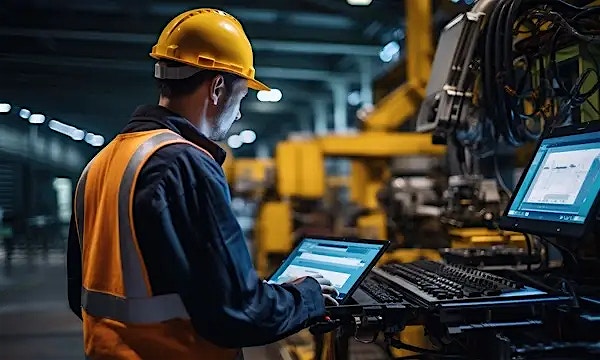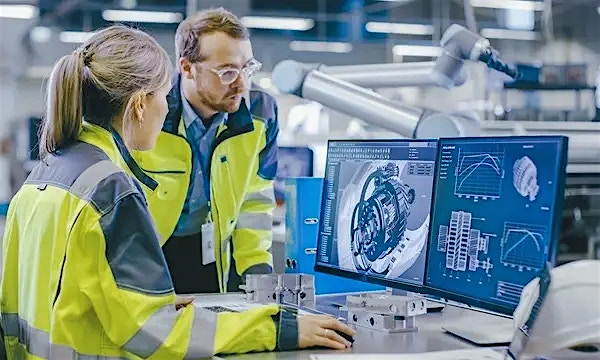When it comes to supply chain innovation, robots are no longer confined to science fiction but are actively reshaping distribution center management and logistics. With advancements in technology and automation, robots have become indispensable assets in modern warehouses.
Over the next five years, the adoption of robotics in warehouses is expected to increase by 50%, according to Material Handling Institute. The goal is mechanical orchestration, in which a team of robots, steered by sophisticated software and artificial intelligence, can move boxes and products seamlessly.
Erik Nieves, Chief Executive of Plus One Robotics, which has teamed up with Yaskawa America to bring robotic arms to a FedEx sorting facility in Memphis, emphasizes the urgency of adopting robotics in warehouses. “I worry for those owners who don’t do it. Even today, a lot of warehouses are just racks, a cart and a clipboard. They’re just not able to keep up,” Nieves said.
Rise of robotics in distribution centers
According to MarketsandMarkets, the global market for warehouse robotics is expected to reach $10.5 billion by 2028 from $6.1 billion in 2023. This rapid growth highlights the increasing adoption of automation technologies as businesses strive to stay ahead in a market driven by ecommerce expansion and heightened consumer expectations.
From autonomous drones buzzing overhead to collaborative robots working seamlessly alongside human operators, the adoption of robotics in distribution centers is fueled by the increasing demand for automation in supply chain operations to meet the challenges of ecommerce, omnichannel distribution and rising customer expectations.
According to the HCLTech Trends 2024 report, the field of advanced robotics is seeing rising accessibility, flexibility and scalability. The ongoing research and development in the field is continuing to advance the capabilities of robots, making them increasingly useful and scalable in a wide range of applications.
Sukant Acharya, Executive Vice President and Global Business Head of IoTWoRKs at HCLTech, says: “In collaborative and critical environments such as healthcare and manufacturing, robotics now comes with optimized productivity, more reliability, improved quality and safety features that are enhanced by advanced deep learning algorithms. More and more sectors, businesses and industries are beginning to prefer robotic automation as a solution.”
Leading technology companies like HCLTech have been helping logistics companies embrace advanced robotics to enhance business outcomes. For example, HCLTech transformed warehouse automation with Robotics Hub Integration for a leading logistics company with 380,000 people in over 220 countries. The integration helped the company expand to new markets and grow business, with around 1.8 billion parcels delivered every year.
The adoption of robotics has seen a significant upsurge in recent years. This growth is fueled by the increasing demand for automation in supply chain operations to meet the varied operational challenges. HCLTech also assisted a leading American beverage firm facing warehouse operational challenges such as limited space, manpower and managing higher volumes of order processing. By partnering with HCLTech, the beverage firm shifted to robotics and automation to enhance its operations management that led to optimized logistics process, significant cost efficiencies and enhanced customer relationships.
Reasons for robotics transformation
Distribution center management transformation through robotics is driven by a multitude of compelling factors. Foremost among these is the imperative to enhance operational efficiency in an increasingly competitive marketplace. By automating repetitive and time-consuming tasks, robotics streamlines processes, minimizes errors and accelerates throughput, enabling distribution centers to meet growing demands with agility.
Amazon, for example, has deployed over 750,000 robots to pick and sort hundreds of thousands of customer orders, taking on highly repetitive tasks. The robotic handling system is called Sparrow and enables employees to better focus on the end customer.
Robotics offers unparalleled opportunities to improve accuracy, particularly in inventory management, order fulfillment and tracking, mitigating the risks of stockouts, discrepancies and delays. Walmart now offers drone delivery at 36 US stores across seven states, showcasing the potential of robotics in inventory management and delivery logistics.
By reducing reliance on manual labor for hazardous or physically demanding tasks, robotics enhance workplace safety and safeguards employees from potential injuries, while promoting a culture of occupational wellness. The scalability and adaptability of robotic systems empower distribution centers to flexibly respond to fluctuating market dynamics and customer requirements, ensuring resilience and sustainability.
Future trends and outlook
Future robotics trends are characterized by continued innovation and integration with emerging technologies. Companies like HCLTech are pioneering the development of AI-powered process automation transformation platforms that can adapt to dynamic warehouse environments, paving the way for autonomous, self-optimizing distribution centers. Looking ahead, several key trends and developments are shaping the future landscape of robotics.
Advanced AI integration: AI-powered robotic systems are not only optimizing existing processes but also enabling predictive analytics and decision-making capabilities, driving proactive and adaptive operations. Machine learning algorithms are enabling robots to learn from data, refine their performance over time and dynamically respond to changing operational conditions.
Expansion of collaborative robotics (Cobots): Collaborative robots or cobots are playing an increasingly prominent role in distribution management, facilitating seamless interaction between humans and machines. These cobots are designed to work alongside human operators, enhancing productivity and safety in warehouse environments. With advancements in sensor technology and safety features, cobots are becoming more versatile and capable of performing a wider range of tasks, from pick-and-place operations to collaborative assembly tasks.
Integration with Internet of Things (IoT) and connectivity: Robots in distribution management are increasingly being integrated with the Internet of Things (IoT) and connected devices, enabling real-time data exchange and remote monitoring capabilities. IoT sensors embedded in robotic systems are providing granular insights into warehouse operations, from inventory levels and equipment status to environmental conditions.
Sustainability and green robotics: The future of robotics is also being driven by a growing emphasis on sustainability and eco-friendly practices. Green robotics initiatives focus on minimizing energy consumption, reducing carbon emissions and optimizing resource utilization within the distribution environment. From energy-efficient robotic systems to eco-friendly materials and packaging solutions, sustainability is a key driver of innovation in the robotics industry.
Safety concerns and compliance in robotics
Between 1992 to 2017, workplace robots were responsible for 41 recorded deaths in the United States. Recently, at an Amazon warehouse, malfunctioning robotics arms in a distribution center caused injuries to the workers. Incidents like this highlight the importance of stringent safety measures and comprehensive training programs. Regulatory bodies like the US Occupational Safety and Health Administration (OSHA) enforce standards to ensure worker safety where robots are employed.
While robots are designed for safety, accidents and compliance issues are critical considerations in the integration of robotics within distribution centers. Organizations must prioritize risk assessments, robust safety training and continuous monitoring to mitigate risks associated with robotics operations.
The convergence of advanced technologies, intelligent automation and sustainable practices is reshaping the way warehouses operate, while driving continuous improvement in efficiency, productivity and sustainability across the supply chain.
As organizations embrace these emerging trends in robotics, they will be better positioned to navigate the complexities of modern logistics and achieve competitive advantage in a dynamic marketplace.





